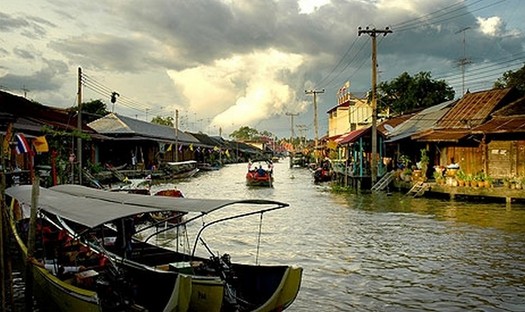
October 8, 2010
Applying the Design Revolution to the Woes of Big Canals

Tarbela Dam
The 13,324 miles of canal system in Pakistan’s Sindh province irrigates 12 million acres of land. That’s a canal that’s long enough to cross the United States three times! This canal system and others like it make as significant a contribution to feeding the world’s growing population as the introduction of the green revolution’s miracle seeds.
But big canals come with big problems. Namely, rampant corruption, water wastage, numbingly inefficient operation and maintenance as well as millions of acres of productive land ruined through water logging and salinization. Because of water losses from evaporation, leakage, evaporation, poor operation and maintenance and prehistoric methods of flooding fields, most canals unfortunately end up delivering 60% or less of the water they were designed to deliver.

Thal Canal
The poorer farmers at the tail end of the canal get the short end of the stick. They get less water less often. The bigger richer farmers at the head of the canal are not similarly afflicted, as they are able to use payoffs and political influence to get the lion’s share.
With three billion new people predicted on planet earth in 25 years I believe that the only option we have in the long run is to convert the majority of existing canal irrigation to more efficient sprinkler and drip.
But this presents a big challenge.
Big canals use complex rotation systems to deliver water to fields only every 12 days or so. Drip and sprinkler systems, however, need to apply water to plants every two to four days.

Flood Irrigated Field
With the existing 12 day rotation and flood irrigation cycle, plants are waterlogged for a couple of days, have optimal moisture for a few days, and are then starved of water for the last few days until the next 12 day cycle repeats the process. Much like the demand feeding of infants, water delivered frequently by drip and sprinkler creates healthier plants, higher yields, and improved crop quality.
How can we bridge the water delivery gap in a way that favors the tail-enders and smaller farmers that have been getting the short end of the stick? The answer is simple.
The recent emergence of low cost small plot drip and sprinkler systems combined with low cost water storage makes it possible to deliver water to crops every two to four days, and at the same time provide disadvantaged tail-enders with a level playing field.
Every farmer with access to a canal can build a simple low cost water storage pond with a plastic liner. The farmer fills the pond every 12 days when the canal delivers water. Poor farmers use a low cost pressure treadle pump every three or four days to lift water from the pond into a low cost drip or sprinkler system that delivers it efficiently to their crops.
The beauty of this is that each farmer can design and build the right size of holding pond he needs, depending on the volume of water he receives from the canal, the time until the next canal water delivery, the acreage he plans to irrigate, and the water requirements of the crop. Best of all, since small plastic lined ponds and low cost drip and sprinkler systems are cheap, they can be installed by private sector entrepreneurs supported by credit, with savvy farmers earning at least twice their investment back in the first year.
By growing intensively cultivated diversified drip-irrigated off-season fruits and vegetables, tail-enders can earn $1,000 in net income from a quarter acre plot!
For example, a poor farmer at the tail end of a canal who gets water delivered every 30 days and decides to grow a quarter-acre of diversified off-season vegetables needs about three liters of water/day/sq meter in the dry season. To irrigate 1,000 sq m for 30 days requires 3,000 x 30 = about 90,000 liters of water storage. That’s a plastic lined pond about seven meters long, seven meters wide, and two meters deep. If he uses his own labor, he should be able to build it for about $200 (a plastic cover isn’t needed for short term storage).
Now I can already hear irrigation experts snickering about this shabby looking ugly duckling of a rustic pond lined with plastic – a good solid cement tank would be much more substantial! But the pond with the plastic liner is affordable and effective, even if it lasts three years instead of ten. And in three years the farmer will earn enough income to build a beautiful cement tank if he wants to.
In India, a drip system will cost about $100, and a pressure treadle pump about $40. The farmer should be able to build the whole system and plant his crop for $500 or less, and earn $1,000 in the first year if he or she has learned intensive horticulture. Access to credit will make the whole system sing.
Richer farmers at the head end of the canal can also benefit. They can now make the irrigation water they get go twice as far by building larger water storage ponds and installing larger conventional drip and sprinkler systems powered by electric and diesel pumps. But we need to implement safeguards that inhibit their arranging to get an even bigger share of water than they currently get.
Installing on-farm low-cost water storage combined with low cost drip and sprinkler irrigation will level the playing field for smaller, poorer farmers at the tail end of large canal systems. A parallel strategy can improve the yield and quality of crops grown by richer farmers as well. Converting canals to drip and sprinkler irrigation can double the crop and income produced by each drop of available irrigation water at a time that planet earth desperately needs practical solutions to rapidly escalating regional water shortages.
Observed
View all
Observed
By Paul Polak
Recent Posts
A quieter place: Sound designer Eddie Gandelman on composing a future that allows us to hear ourselves think It’s Not Easy Bein’ Green: ‘Wicked’ spells for struggle and solidarity Making Space: Jon M. Chu on Designing Your Own Path Runway modeler: Airport architect Sameedha Mahajan on sending ever-more people skyward
 Dr. Paul Polak is the author of Out of Poverty: What Works When Traditional Approaches Fail, which has become a renowned resource for practical solutions to global poverty. His new book, co-authored with Mal Warwick is the Business Solution To Poverty, Designing Products and Services For Three Million New Customers.
Dr. Paul Polak is the author of Out of Poverty: What Works When Traditional Approaches Fail, which has become a renowned resource for practical solutions to global poverty. His new book, co-authored with Mal Warwick is the Business Solution To Poverty, Designing Products and Services For Three Million New Customers.



